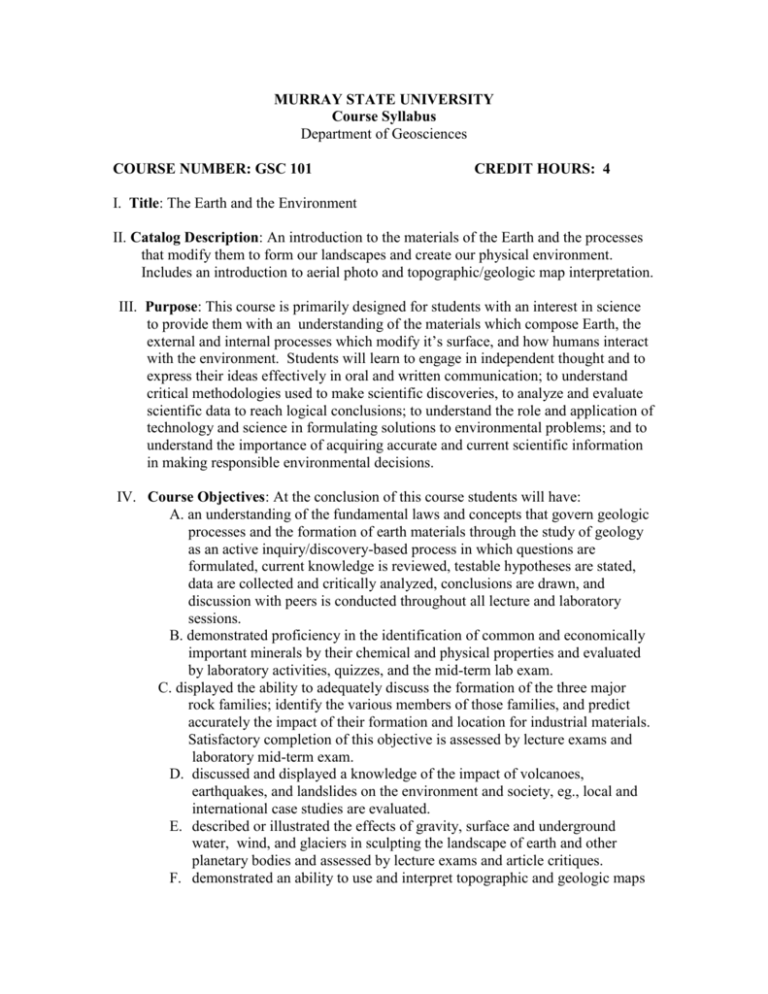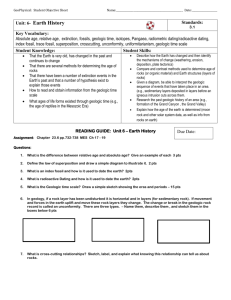Course Syllabus - Murray State University
advertisement

MURRAY STATE UNIVERSITY Course Syllabus Department of Geosciences COURSE NUMBER: GSC 101 CREDIT HOURS: 4 I. Title: The Earth and the Environment II. Catalog Description: An introduction to the materials of the Earth and the processes that modify them to form our landscapes and create our physical environment. Includes an introduction to aerial photo and topographic/geologic map interpretation. III. Purpose: This course is primarily designed for students with an interest in science to provide them with an understanding of the materials which compose Earth, the external and internal processes which modify it’s surface, and how humans interact with the environment. Students will learn to engage in independent thought and to express their ideas effectively in oral and written communication; to understand critical methodologies used to make scientific discoveries, to analyze and evaluate scientific data to reach logical conclusions; to understand the role and application of technology and science in formulating solutions to environmental problems; and to understand the importance of acquiring accurate and current scientific information in making responsible environmental decisions. IV. Course Objectives: At the conclusion of this course students will have: A. an understanding of the fundamental laws and concepts that govern geologic processes and the formation of earth materials through the study of geology as an active inquiry/discovery-based process in which questions are formulated, current knowledge is reviewed, testable hypotheses are stated, data are collected and critically analyzed, conclusions are drawn, and discussion with peers is conducted throughout all lecture and laboratory sessions. B. demonstrated proficiency in the identification of common and economically important minerals by their chemical and physical properties and evaluated by laboratory activities, quizzes, and the mid-term lab exam. C. displayed the ability to adequately discuss the formation of the three major rock families; identify the various members of those families, and predict accurately the impact of their formation and location for industrial materials. Satisfactory completion of this objective is assessed by lecture exams and laboratory mid-term exam. D. discussed and displayed a knowledge of the impact of volcanoes, earthquakes, and landslides on the environment and society, eg., local and international case studies are evaluated. E. described or illustrated the effects of gravity, surface and underground water, wind, and glaciers in sculpting the landscape of earth and other planetary bodies and assessed by lecture exams and article critiques. F. demonstrated an ability to use and interpret topographic and geologic maps for basic environmental applications primarily through laboratory activities as evaluated by lab exams and quizzes. G. discussed the generation of geologic structures (faults, folds, impact craters) and how these features are related to volcanoes, earthquakes, meteorite impact and global tectonics evaluated by lecture exams and article critiques. These objectives are applicable to Kentucky core content for assessment: SC-HS-4.6.8,SC-08-2.3.3,SC-08-4.6.1,SC-HS-4.6.9,SC-08-1.1.4,SC-08-4.6.2,SC-HS-4.6.4 SC-08-2.3.4,SC-HS-2.3.7,SC-08-2.3.1,SC-HS-2.3.8,SC-08-2.3.2,SC-HS-2.3.10,SC-08-4.7.2 SC-HS-4.7.3, SC-HS-4.7.4 V. Content Outline: Scientific Method Chapter 1, p. 22-23 The Science of Geology Chapter 1 Atoms, Elements, and Minerals Chapter 2 Rock Families (Brief Description) pp. 60-66,70-75,94-97,139-154,171-184 Rock Cycle pp. 58 Laws of Stratigraphy pp. 195-206 Relative and Numerical Ages of Rocks Chapter 8, pp.207-214 Geologic Time Scale pp. 214-218 Compositional and Mechanical Structure of Earth pp. 445-452 and pp. 588-590 Plate Tectonics Chapter 19 Strike, Dip, Folds pp. 382-390 Joints and Faults pp. 391-400 Earthquake Mechanisms/Case Studies/Northridge /Kobe/New Madrid Chapter 16 Igneous Activity Chapter 4, pp. 86-93 Volcanoes/Case Studies/Mt. Pinatubo pp. 97-112 Weathering Processes pp. 117-128 Differential Weathering Lecture notes Soil Formation pp. 129-135 Mass Wasting Chapter 9 Classification and Control of Mass Wasting Lecture notes Ground Water pp. 284-293 Karst Formation pp. 293-300 Streams pp. 248-263 Drainage Patterns and Their Significance Lecture notes and pp. 250-252 Alpine and Continental Glaciers pp. 308-329 Causes of Glacial Ages pp. 330 Deserts and Wind Action Chapter 13 Waves, Beaches, and Coasts Chapter 14 The professor reserves the right to adjust the exam dates to a later time if needed to match the progress of lecture presentations. VI. Instructional Activities: A. This course is designed to promote scientific literacy associated with the geologic environment through active learning. Since this course is taught primarily as a large assembly, active learning activities are more readily utilized in the laboratory session; but modified techniques are still used in the lecture. Group discussion, pair-sharing, and collaborative research dealing with case studies of historic geologic phenomena and current global environmental issues are utilized. B. GSC 101 also promotes critical thinking skills by helping the student develop an investigative approach to asking questions and synthesizing answers about the geologic environment. All weekly laboratory assignments require written responses and an application of the concepts previously discussed. DVDs/CDs are used in the lecture for illustrations of concepts. Scientific articles are also read, discussed and critiqued for validity and utility to society. C. Computer technology is used as a presentation tool in the lecture hall and laboratory. The use of virtual “field trips” for various interesting geologic areas is also integrated into the laboratory sessions. Computer modeling and simulation of important concepts such as plate movement and interaction; earthquake generation; and volcanic eruptions are also utilized. Access to the Internet for current geologic activity is a very important component of this course to conduct the virtual “field trips.” These “field trips” are used as supplementary/complementary enhancement and are not currently assessed as part of the course grade. D. A short special topics paper will also be completed for a total of 20 points. Details will be discussed in class. VII. Field, Clinical Experiences and/or Laboratory Experiences: Students are required to complete a minimum of 30 contact hours of laboratory experience. This involves hands-on activities for minerals and rock identification, the construction of topographic maps and profiles and aerial photo/image interpretation applications. A field trip is scheduled for later in the semester. Details will be discussed in class. VIII. Resources: Rock and mineral samples; topographic and geologic maps; stereoscopes; DVDs/CDs, internet access. IX. Grading Procedures: Lecture Test I 100 pts Lecture Test II 100 pts Lecture Test III 100 pts Final Exam 100 pts Lect. Ave. is four (4) test grades Short Special Topics Lab average = 400 pts, 65% total grade = 20 pts = 35% total grade Lab must be completed in order to receive a grade in the course! The professor reserves the right to adjust the exam dates to a later time if needed to match the progress of lecture presentations. Any lecture exam that is missed will be made-up within 2 weeks of the regularly scheduled exam. The make-up exam is entirely essay format. X. Attendance Policy: In the real world attendance is an important part of ones job performance, thus attendance will be taken. I reserve the right to fail any student who has missed 10 or more meetings. Absence from class even if you get notes from a fellow student is not as good as your presence and your notes. Students who do not attend class do not do well. If one does not miss over 3 lectures, 10 points will be added into the total to calculate the overall average. Please refer to page 10 of the 2005-2007 Murray State Undergraduate Bulletin. XI. Academic Honesty Policy: Cheating, plagiarism (submitting another person’s material as one’s own, or doing work for another person who will receive academic credit) are all impermissible. This includes the use of unauthorized books, notebooks, or other sources in order to secure or give help during an examination, the unauthorized copying of examinations, assignments, reports or term papers, or the presentation of unacknowledged material as if it were the student’s own work. A grade of zero will be given for the assignment which has been submitted dishonestly. A second offense will result in a failing grade for the course! Please refer to the page 10 of the 2005-2007 Murray State Undergraduate Bulletin. XII. XIII. Text and Reference: Text: Physical Geology, Plummer, McGeary and Carlson 11th edition Lab Manual: Laboratory Manual for Physical Geology, 5th Edition, Jones & Jones Prerequisites: None XIV. STATEMENT OF AFFIRMATIVE ACTION AND EQUAL OPPORTUNITY: Murray State University does not discriminate on the basis of race, color, national origin, sex, religion, marital status, age, or disability in employment, admission, or the provision of services, educational programs and activities, and provides, upon request, reasonable accommodation including auxiliary aids and services necessary to afford individuals with disabilities an equal opportunity to participate in all programs and activities. For information regarding nondiscrimination policies contact the Office of Equal Opportunity, 270-809-3155. GSC 101 Lab Schedule Week Subject Assignment Date T u 1 2 3 4 5 6 Ore Minerals Rock Forming Minerals Igneous Rocks Sedimentary Rocks Metamorphic Rocks Mineral and Rock Exam Chapters 1 & 2 Chapters 1 & 2 Chapters 3 Chapter 4 Chapter 5 Lab Instructors Must Get Mid-Term % to Lecture Instructors by March 2, 2007 7 8 Topographic Maps GPS/Map Coordinates/ Land Division/ Remote Sensing Chapter 6 Chapter 7 9 10 11 12 13 14 Plate Tectonics/Sea Floor Spreading Chapter 17 Structural Features of Sedimentary Rock Chapter 14 Interpretation of Geologic Maps Chapter 15 Streams Chapter 8 Ground Water Chapter 9 Second Lab Exam Covering Materials from Week 7-13 2 Lab Instructors must get final grades to Lecture Instructors Lab Manual: Laboratory Manual for Physical Geology, 5th Ed. Jones and Jones General Information A lab instructor will permit in his or her lab ONLY STUDENTS WHO ARE LISTED ON THE COMPUTERIZED ROLL FOR THAT LAB. YOU ARE REQUIRED TO ATTEND LAB; AND TO REMAIN IN IT UNTIL ITS END, unless you can demonstrate that you have completed the assignment to the satisfaction of the lab instructor. Absences will be reported to your lecture instructor. Lab instructors will not accept any assigned work over one (1) week past due. YOU MUST TAKE BOTH EXAMS (ROCKS EXAM AND MAPS EXAM) to obtain a lab grade for this course. Jan 23 Jan 30 Feb 6 Feb 13 Feb 20 Feb 27 W Jan 24 Jan 31 Feb 7 Feb 14 Feb 21 Feb 28 No letter grade will be given for lab; only a numerical grade (based on 220 pts) will be given by your lecture instructor. Method for determination of lab grade: Minerals and Rocks Exam -33-1/3%; Second Exam -33-1/3%; Quizzes and Homework -33-1/3%. No make-ups for the weekly pop quizzes will be given, regardless of the reason. A make-up exam for the Minerals and Rocks Exam or Second Exam will be given only for students with excused absences as described on page 10 of the University Undergraduate Bulletin 2005-2007.






